Battle of the Trade Associations:
NAB vs. CTIA Spectrum Fight
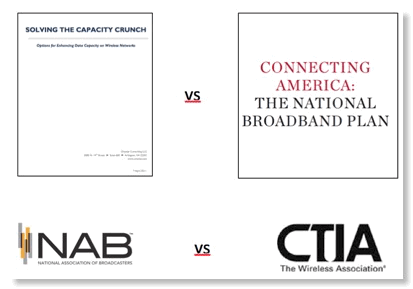
Readers of this blog are probably aware that your blogger is not greatly loved at either NAB or CTIA. While NAB staff at least return phone calls and e-mail messages after a while, CTIA staff do not - apparently their response to criticism herein.
This week NAB released the report shown above, SOLVING THE CAPACITY CRUNCH: Options for Enhancing Data Capacity on Wireless Networks.
The NAB press release, entitled “Study Discredits Claim of Spectrum Crisis for Mobile Broadband--FCC filing offers spectral efficient solutions to address capacity crunch”, starts,
“The National Association of Broadcasters yesterday filed with the FCC a study by former FCC official Uzoma Onyeije questioning the existence of a spectrum crisis. The paper, entitled ‘Solving the Capacity Crunch: Options for Enhancing Data Capacity on Wireless Networks’, suggests alternative solutions to auctioning broadcasting spectrum to help alleviate mobile broadband congestion.”
(The report is certainly available on the NAB website, as shown in the link above,but finding it at FCC is trickier. It is at p. 37-72 of this joint NAB/MSTV filing in Docket 10-135.)
I have worked with the author both at FCC and more recently as a consultant when he was at M2Z Networks and I have the highest regard for him. But the NAB characterization of him as a “former FCC official” is typical of NAB consistently hiring consultants who are “predictable” and then spinning their reports while fuzzifying their qualifications for the issue at hand. Mr. Onyeije has degrees in accounting and law and does not claim qualifications in telecom technology other than his tenure at FCC as Broadband Legal Advisor to the Chief of the FCC's Wireless Telecommunications Bureau. That said, however, I have to agree with much of what he said with respect to technical options for the 500 or 800 MHz “needed” for broadband.

Onyeije ’s report is also reminiscent of an “associate item” OET’s predecessor OST prepared for the Commission in 1983 on this subject of meeting spectrum growth. Even if you have been in the spectrum area within the FCC for 20 years, you may not have heard the term “associate item”. This was a proper procedure, defined in the FCC’s internal Agenda Handbook, for FCC bureaus and offices to let the Commission know they disagreed with an agenda item put for by another element. (It appears that this internal FCC procedure disappeared in the 1980s and this may well be the last such associate item ever sent to the Commission by the staff as staff disagreements were then frowned upon by the “8th Floor”. Was the elimination of associate items actually an improvement?)
OST disagreed that the only way to meet projected demands was through more spectrum and pointed out to the Commission the spectrum demands can often be a self-fulfilling prophecy if they are denominated in MHz and that technology is key to converting actual information transfer needs into MHz. Of course, we now know that will cellular architecture capital investment in infrastructure is another key factor - but that was not so clear in 1983.
The 1983 OST associate item stated as a “basic concern”:
“We believe that the technology projection in the report are generally too pessimistic on equipment availability and its impact on spectrum needs and neglect the close relationship between equipment development efforts and the regulatory climate...We feel that the Commission can create a regulatory climate where ... new technologies would become available for (mobile) users. Such regulatory climate would also have the side effect of increasing the competitive position of the U.S. communications industry in the world market.”
These words were written 28 years ago, but are quite meaningful today also. While the Commission and NTIA are busy focusing on the Broadband Plan’s 500 MHz goal, they don’t seem to be paying much attention to the Docket 09-157 wireless innovation issues in the 610 days since that NOI was issued.
Society and the economy do not need x MHz to meet their needs, they need communications capacity. Wireless communication capacity is in turn achieve through a combination of
- spectrum
- technology and
- investment in infrastructure
UPDATE
CTIA response to Onyeije report
Section 7 & Wireless Innovation: IEEE-USA Letter to FCC

Since the passage of Section 7 in 1983 in response to the Commission’s endless delay in resolving issues about an innovative narrowband land mobile technology, it has carefully tried to avoid ever mentioning the existence of this provision in both decisions and publications. Section 7 is not a perfect piece of legislation. It has an explicit deadline, yet doesn’t state exactly what has to be done within that period.
The IEEE-USA letter points out that the Commission does have explicit guidelines for review of pending mergers and forbearance petitions pursuant to Section 10(c) of the Act that both give nominal time schedules. However, there is no analogous guidance on Section 7 issues.
The letter also pointed to recent White House initiatives to speed up patent review to expedite innovation:
We believe that FCC might wish to emulate the White House’s recent Startup America initiative “to dramatically increase the prevalence and success of America’s entrepreneurs.” Under part of this program the Patent and Trademark Office (PTO) will offer an Enhanced Examination Timing Control Initiative “to give innovators more control over the application processing and support a more efficient market for innovation.” For wireless innovations subject to non- routine FCC approvals, FCC deliberations determine if and when diffusion, and thus positive cash flow, is possible. In contrast, the improved and more timely PTO decisions only scope the level of intellectual property protection were these cash flows possible. We urge the FCC to examine this PTO initiative and consider offering to entrepreneurs parallel programs to resolve policy deliberations on a faster, more predictable basis.
FCC has a poor track record in responding to this type of suggestion. Let’s hope they are more attentive this time. If others with like views tell Chmn. Genachowski their views, more may happen.
vox populi, vox dei
Mark Stone Joins the WAM*
“We are excited that Mark Stone will be joining our Team as John departs. I have had many opportunities to work with Mark over my years here, as he has performed myriad tasks for the FCC. I especially recall the advice and counsel he shared with me as I suddenly found myself Acting Chairman of the Commission in 2009. His knowledge of how the place runs and his mastery of how to get good things accomplished was, and remains, immensely helpful to me—and to the ongoing work of the Commission. He has an excellent grasp of how things here work—both policy and administrative—and he goes about his job with skill, good judgment and a most collegial and pleasant demeanor. I look very much forward to working with Mark in the months ahead and thank him for agreeing to undertake this assignment.”
Mark, who holds an undergraduate degree in Business Administration from James Madison University and a Juris Doctorate from George Mason University, started his public service in 1991 at the General Services Administration’s Office of Inspector General. He joined the Commission in 1994 as an auditor and staff attorney in the Accounting Safeguards Division of the Common Carrier Bureau. He then served as an attorney in the Enforcement Bureau’s Investigations and Hearings Division, focusing on common carrier matters such as merger conditions and Section 271 later moving on to become Deputy Chief of the Bureau's Telecommunications Consumers Division.
Mr. Stone most recently served as Legal Advisor to the Chief of the Enforcement Bureau on common carrier matters. He has also held posts in the Office of Managing Director and served as an advisor to former Commissioner Jonathan Adelstein and former Chairman Kevin Martin. In his current role as Deputy Chief of the Consumer and Governmental Affairs Bureau, Mark has been deeply involved in core consumer protection matters including bill shock, truth-in-billing and disability access.
* Wireless Advisors Meeting - the regular meetings between the commissioners’ wireless advisors and the FCC bureaus and offices involved in wireless policy where much of the decisions are worked out and reviewed.
The Mystery of the Changing FCC Seal
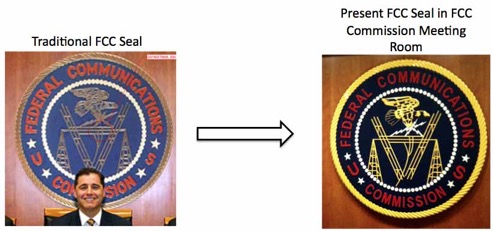
If you look carefully at the 2 photos above, you can see that the FCC seal in the Commission meeting room has changed during Chmn. Genachowski’s tenure.
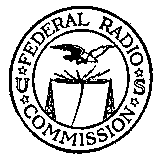
Dane Eriksen, a fellow FCC/FOB alum and a prominent broadcast engineering consultant, has sent the following note to the Chairman:
April 8, 2011
Dear Chairman Genachowski:
Congratulations on the new FCC web site. I couldn't help noticing, though, that there appears to be a wiring error on the antenna array shown in the FCC seal on the lower left-hand corner of the web pages. Indeed, it's on most versions of the FCC seal that I could find. The attached PDF file shows the problem. What puzzles me is that a few versions of the seal have the wiring correct; for example, the FCC seal in the main meeting room of the FCC, as shown in the last picture in the PDF file.
Not that you don't have more pressing issues, but my suggestion for the FCC "Reboot" project is therefore to hunt down and replace all of the incorrect versions of the FCC seal.
(Dane’s .pdf attachment)
Here is the “wiring error” that Dane is talking about:

In the traditional FCC seal, the feed line splits and goes to all 3 horizontal antenna wires. In the new version, one of the 3 wires after the split goes to the bottom wire and 2 go to the top wire.
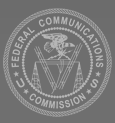
But replacing such a large seal with a new custom one will no doubt cost hundreds of dollars that FCC can ill afford at the moment. However, fixing the electronic files used on the website can be done in a few minutes with Photoshop and can stop this error from propagating. When resources permit, the Meeting Room seal should be replaced. Who knows, maybe it can even be repaired at an affordable cost?
Europe's Broadband Plan
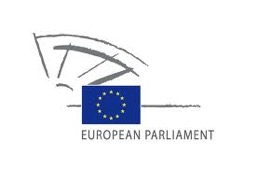
MEPs are keen for Europe to compete with other global players and meet increasing consumer and business demand for mobile internet with an array of new services.
In its vote on Tuesday, the Industry Committee gave strong backing to the Commission's plans for a draft Radio Spectrum Policy Programme (RSPP), a central plank of the Digital Agenda for Europe, which aims to deliver universal fast broadband internet coverage with speeds of at least 30 Mbps for all Europeans by 2020.
This can be done by allocating the "digital dividend" - the radio frequency bands that will be freed up when EU Member States switch from analogue to digital television broadcasting - to new services, particularly mobile internet.
Rules on how to divide up the spectrum among providers and users of the net need to be set at European level. RSPP will help coordinate the use of the spectrum and also provide for maximum flexibility and availability.
800 MHz - mobile internet frequency from 2013
Under the Commission's plans, EU countries would have to make the 800 MHz waveband available for harmonised use of wireless broadband services by 1 January 2013. The Industry Committee passed an amendment which would allow Member States to ask for a postponement until the end of 2015, or even longer, if they have problems in cross-border frequency coordination with neighbouring third countries.
After 2013, MEPs want the EU to be even bolder. They say spectrum allocated for mobile data traffic should reach at least 1200 MHz by 2015. In addition, the Commission should monitor technological developments and the efficiency of spectrum use to assess if additional frequencies (such as the 700 MHz band) should also be harmonised to make room for new users and services.
Level playing field for all
Regulators should encourage effective and efficient use of frequencies, while also carefully examining whether the assignment of new frequencies could distort competition in the market, says the Industry Committee.
For example, Member States could limit the scope of the spectrum per operator or reserve part of it for future new providers. At the same time, procedures for allocating frequencies should be non-discriminatory and seek to prevent anti-competitive outcomes.
This development of the internal market and digital services should eventually provide a pan-European level playing field for all market participants and lead to pan-European services in future.
Precondition for the EU to take the global lead in mobile internet
Rapporteur Gunnar Hökmark (EPP, SE) welcomed the overwhelmingly vote in the committee (46 votes in favour, 1 abstention) as "very good news for the European economy" and called for the programme to "pave the way for a development where the EU can take the global lead regarding broadband speeds, mobility, coverage and capacity".
The full Parliament will vote at first reading on the Commission proposal as amended by the Industry Committee at the June plenary in Strasbourg.
FCC Test Drives New Website Design
It is unclear whether the new website addresses a major problem of the old website: nobody was really in charge and lots of people could clutter the “prime real estate” of the home page with their pet projects and announcements. Presently, it has a new type of clutter - 6 videos of bureau chiefs talking on their favorite topics. One wonders if all 5 commissioners will demand equal time?
Another observation is that the new design still takes more than 2 screens to display the whole vertical height. Now Whitehouse.gov also needs 2 screens, but a lot of agencies like the previously discussed FERC are able to organize their whole complex mission into 1 screen full.
The FCC explained the philosophy of the new design in a press release. The Commission also welcomes comments on the new design.
Incentive Auction Incentive Program
Congratulations to the FCC team for this brilliant breakthrough! And thanks for FHH for bringing it to our attention in a timely way.
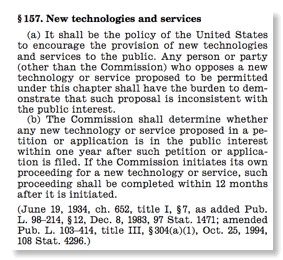
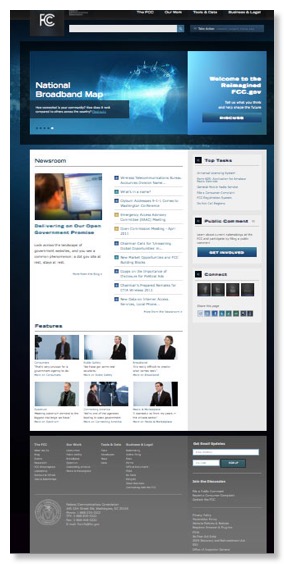
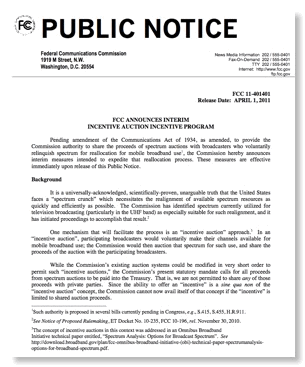


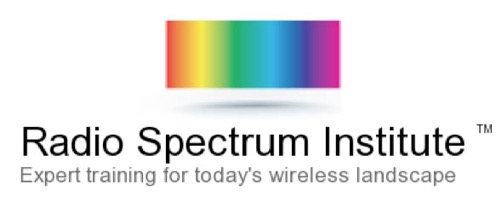


![Validate my RSS feed [Valid RSS]](valid-rss-rogers.png)

